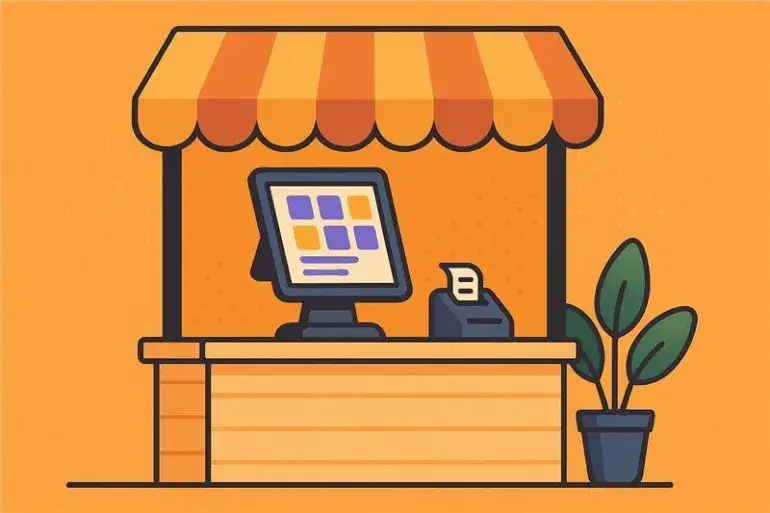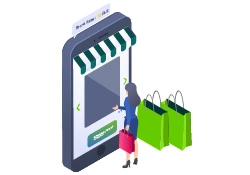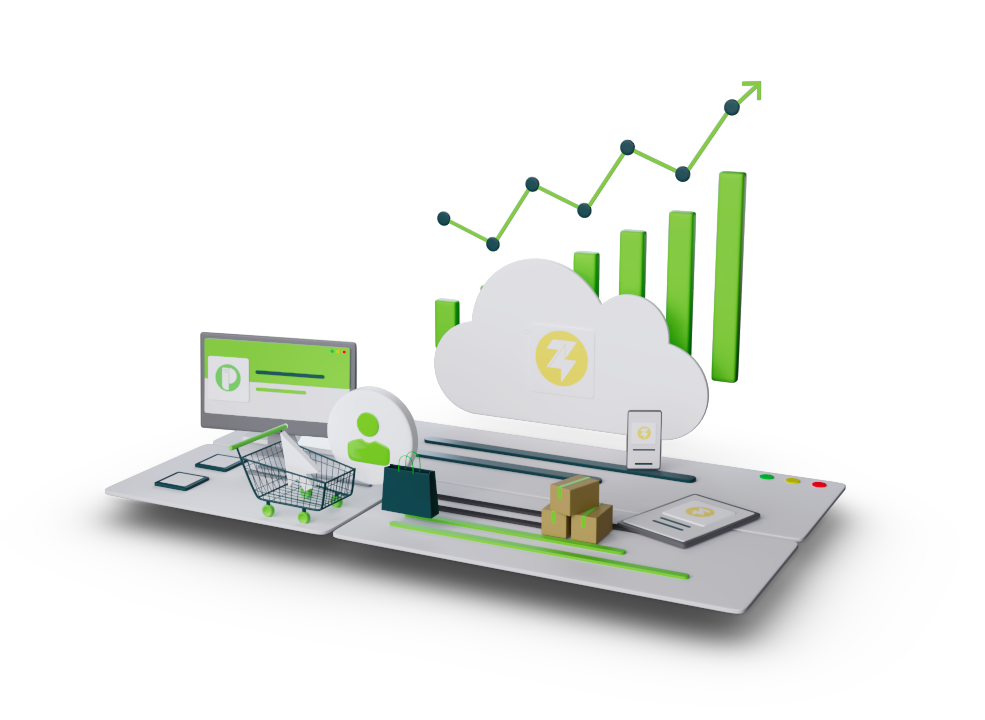POS for Pop-Up Retail: How Temporary Stores Can Leverage Mobile Solutions for Success

Pop-up retail has emerged as a creative way for brands to connect with customers on the go, test markets, and create buzz for new product lines. These short-term shops now generate roughly $80 billion in annual revenue and are considered successful by nearly 80% of retailers that try them. This explosive trend encourages experimentation but also brings challenges. Because pop-ups lack permanent infrastructure, retailers need flexible and efficient tools to serve customers quickly on the spot.
Mobile POS or point-of-sale systems answer this need. Using smartphone or tablet-based POS, pop-up teams can register sales from anywhere, manage inventory in real time, and integrate payments with online customer profiles. In fact, most brands are now investing in “sell anywhere” tools like mobile POS.
In this blog, we’ll lay the roadmap for using mobile POS in temporary retail, from improving speed and service, to on-the-go analytics, to effortless backend integration. We’ll also look at how platforms like Ginesys make this very simple.
How Mobile POS Revolutionizes the Pop-Up Checkout
Mobile POS solutions have changed the way temporary retail spaces operate, most notably by transforming the pop-up checkout. Instead of being limited at a traditional checkout counter, store associates can move freely with handheld devices and complete transactions anywhere on the site.
- Mobility and flexibility: Staff can process sales from the shop floor, at product displays, or even outside the booth. This reduces queuing and improves customer flow with its “checkout-at-the-customer” convenience (also known as queue busting).
- Speed and efficiency: Barcode scanning, contactless tap, QR code payments, and digital receipts make transactions almost instantaneous. With item lookup and tax calculation built into the system, staff can process sales quickly without error.
Budget-friendly scalability: Mobile POS requires minimal hardware, typically just a tablet or smartphone and a small card reader. Subscription-based pricing models over big capital outlays further minimize any upfront costs, making it an ideal choice for short-term retail formats.

Simplify omnichannel retail with one POS solution that works smoothly across online, in-store, and on-the-go setups.
Creating Standout Customer Experiences in Temporary Retail
With mobile POS capabilities, stores can deliver highly personalized service. Beyond processing payments, it also enables associates to become brand ambassadors empowered to improve the customer journey at all touchpoints.
- Personalization: Instead of just scanning a barcode, an associate can pull up a customer’s loyalty profile, past purchases, or current promotions directly on their device. They can then make recommendations or upsell on the spot.
- On-the-spot engagement: A handheld POS turns the checkout into a point of engagement. Staff can walk customers through product features, apply discounts, issue gift vouchers, or award loyalty points, all while checking them out.
- Faster, smoother checkouts: Pop-up store shoppers build satisfaction and loyalty thanks to instant service and convenience. Retailers using mobile POS have reported higher conversion rates during peak events, as associates can move around and process frictionless transactions anywhere. It also improves the likelihood of impulse purchases.
The checkout thus becomes part of the brand persona, a fast, friendly, and even fun process rather than a last-minute obstacle.
Managing Inventory in Real-Time Across the Mobile Retail Setup
Real-time stock visibility leads to better decisions on the spot. Pop-up stores often carry curated selections with a limited stock, so managing inventory in real time is essential. Mobile POS synchronizes stock levels as sales happen in real time. When a staff member rings up an item, the inventory count updates instantly in the cloud. This prevents overselling a really popular style or scanning a “sold out” SKU, all of which could disappoint customers. As the POS ties into a centralized product catalog, any price or assortment changes also reflect in the pop-up device instantly.
Data gathered during an event directly feeds into future planning. A well-run pop-up store becomes a live test for demand, helping retailers identify which SKUs performed best and which promotions converted. These stores can be strategically used to offload slow-moving inventory with targeted offers, turning them into opportunities for smarter stock management.

Connect every pop-up to your central ERP and inventory system with Ginesys’s unified POS platform.
Tapping into Real-Time Sales Insights with Mobile Analytics
One of the major advantages of modern POS software is its data. As transactions flow through the system, every sale is logged with time, item, price, customer and more. This data offers immediate insights like foot-traffic counts, peak-hour sales, and best-selling products become clear.
The POS’s dashboard can show sales vs. time graphs or heatmaps to inform quick decisions on promotions or layout. Modern POS solutions have live reporting, allowing teams to monitor key metrics on a mobile device. If a certain promo isn’t generating enough interest, it can be switched out the next hour. On the other hand, if some SKUs are flying off the shelves, the team can upsell on-the-spot or take reorder requests.
After the pop-up closes, its data becomes a goldmine for review. Metrics like total footfall, conversion rate, average sale amount, and dwell time can be compared against goals. Retailers can analyse, for instance, which hours drove the most email sign-ups or which products had low conversions.
Supporting Omnichannel Integration from Booth to Backend
While pop-ups are temporary and local, they mostly do not operate in isolation. For top retailers, they are part of a broader omnichannel strategy. Mobile POS systems are built to synchronize across channels. Buyers at temporary booths are tied into the loyalty program and email database just like shoppers online or in flagship stores. Unified POS APIs ensure that customer profiles, loyalty points, and purchase histories are synchronized across every channel.
On the backend, a good mobile POS centralizes operations. Inventory from pop-ups, stores, and e-commerce flows into one ERP or stock management system. Any price or promotion change is made once and pushed everywhere. Technologies like QR codes, NFC payments, or web-based checkouts are embedded so that a sale can start digitally and finish at the mobile register. Moreover, data on purchases and foot traffic is integrated into the CRM and analytics tools to offer a 360° view of brand performance.

Effortless Pop-Up Launches with Scalable Setup
It is very quick to get mobile POS for pop-ups running. A team can launch a pop-up in minutes using just a few devices. Typically, it only requires a tablet or smartphone and a compact card reader or scanner. Many retailers use off the shelf Android devices they already have.
Mobile POS is essentially plug-and-play. Cloud-based software requires no onsite installation. Add devices to your account, connect to Wi-Fi, and you’re ready to sell. Most systems even allow easy scaling. If you need a second checkout, just download the app on another device.
This means brands can launch almost anywhere at mall kiosks, street festivals, or campuses with equal ease. Cloud updates and centralized control ensure that the system is ready instantly. Thus, pop-up POS setups can be operational within an hour, compared to days for traditional systems.
Key Metrics to Gauge Pop-Up Retail Performance
Measuring success at a pop-up store is about more than just total sales. It’s important to understand how customers interacted with the space, what drove conversions, and which products performed the best.
Here are some valuable metrics to monitor:
- Foot Traffic vs. Conversion Rate: Track how many people visited the pop-up and what percentage of them made a purchase. Conversion rate = (buyers ÷ visitors) × 100
A high footfall with low conversion could be a sign that there’s an issue with the product mix or layout. - Average Basket Size & Dwell Time: Measure the average transaction value and how long shoppers stayed in-store. Larger baskets and longer dwell times often mean stronger engagement and upselling. Dwell time is the average time each visitor spends in-store. Longer stays indicate more browsing or interest.
- Customer Acquisition & Loyalty Sign-Ups: Count how many new customers were added through email or loyalty programs and how many were later retargeted. Pop-ups act as lead generators, so comparing sign-ups to email opens or reorders shows marketing ROI.
- Sales by SKU & Inventory Turnover: Review which items sold and how quickly. Tracking SKU-level sales and turnover rates can help you optimize merchandising, by informing what to stock, restock, or phase out for future events.

Equip your field teams with enterprise-grade mobile POS that’s quick to deploy and easy to scale.
How Ginesys Empowers Pop‑Up Retailers
Picture this: A premium lifestyle brand launches a three-day pop-up at a bustling mall. Crowds swarm in. Inventory flies off the shelves. But the line at checkout starts stretching dangerously long. Every second lost is a potential sale slipping through the cracks.
Now imagine the same scene only this time, a staffer with a sleek mobile device completes a transaction in the aisle itself. No queues. No friction. Just fast, seamless selling. This is the edge Ginesys delivers.
At the heart of this transformation is Zwing POS, Ginesys’ cloud-based, mobile-first retail solution engineered for agility in fast-paced environments. Built to support retailers where traditional systems fall short, Zwing powers pop-ups shops with precision, speed, and integration that scale. Let's take a closer look at Zwing POS’s features:
- Mobile-First, Omnichannel-Ready, Fully Integrated: Zwing is the mobile-first architecture eliminates the need for bulky hardware. Retailers can launch sales points wherever customers are. With full omnichannel readiness, Zwing syncs online and offline data streams, so every transaction feeds into a unified ecosystem.
- Intuitive by Design: Staffing a pop-up often means working with temp workers or brand reps unfamiliar with retail systems. Zwing removes that barrier. Onboarding is quick and intuitive training often takes less than an hour. Customers scan QR codes to add items to their cart. Zwing supports UPI, credit/debit cards, mobile wallets, and other local payment modes. It’s built to remove bottlenecks, not create them.
- Built for Pop-Ups, Exhibitions, and Beyond: Pop-up operations don’t come with second chances. Delays and system failures cost real money. Zwing mPOS devices work reliably even in high-traffic environments like trade fairs or seasonal bazaars, where network quality can vary. The offline-to-online sync ensures no sale goes unrecorded even if the connection lags temporarily.
- Unified mPOS: Zwing’s mobile POS becomes the nerve centre of your temporary store. Staff can record petty cash transactions, apply custom promotions on the fly, capture new orders, and accept and track payments across methods. All through one handheld device.
- Real-Time Synchronization: Pricing changed mid-event? Inventory updated at the warehouse? Zwing reflects it instantly. Real-time sync ensures that pop-up operations aren’t working off stale data. This is especially critical in high-turnover formats. According to a 2023 report from McKinsey, lack of real-time data is one of the top three reasons retail pop-ups underperform. Zwing makes that risk obsolete.
- Seamless Integration with Core Business Systems: Zwing is part of the larger Ginesys retail suite, and it integrates directly with CRM for personalized marketing, ERP for accurate inventory and procurement, loyalty platforms to retain customers across channels and analytics dashboards for full visibility.
- Scalable, Cloud-Deployed, Ready in Minutes: A key reason retailers hesitate with pop-ups is setup complexity. Zwing solves this. Because it’s cloud-deployed, there’s no need for local servers or IT infrastructure. A store can be live in hours - not days. It runs on common mobile devices (Android/iOS), so no proprietary hardware is required. This flexibility lets brands activate sales points wherever and whenever they want.

Simplify omnichannel retail with one POS solution that works seamlessly across online, in-store, and on-the-go setups.
Temporary pop-up stores are a powerful way to grow brands and engage customers, but only if the right technology is in place. Mobile POS brings speed, flexibility, and data-driven control to even the most temporary setup. Connected cloud POS platforms unify pop-up sales with the rest of the business, enabling real-time inventory sync, shared customer profiles, and cross-channel loyalty.
Ginesys offers a fully integrated mobile POS solution that checks all these boxes. It is lightweight yet powerful, syncing in real time with promotions, CRM, and ERP, and backed by secure cloud infrastructure. Whether you’re launching a one-day kiosk or a city-wide campaign, it ensures your pop-up feels and functions like a permanent part of your brand ecosystem.
Book a demo to see how our mobile POS can power smarter, faster, and more connected retail - anywhere you pop up.
